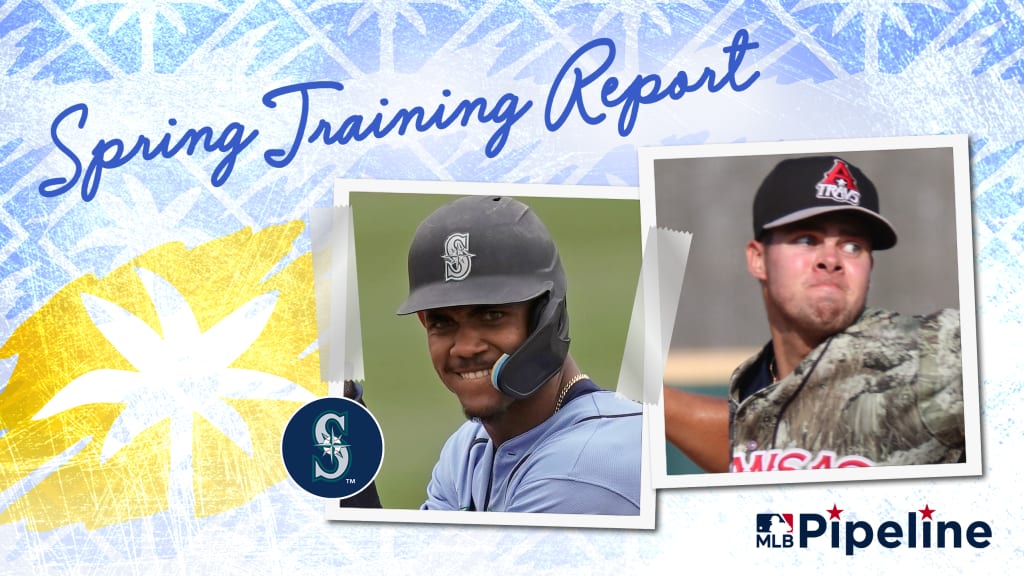
PEORIA, Ariz. -- Mariners senior director of player development Andy McKay spoke to MLB Pipeline from his office at Peoria Sports Complex on Monday. That timing is important.
Later that day, Seattle’s top prospect, Julio Rodríguez, would go 2-for-2 with a double and a walk while playing center field for the seventh time this spring as part of his bid to skip over Triple-A and become a Major League Opening Day starter. One day before that, the club’s No. 3 and No. 6 prospects, George Kirby and Matt Brash, respectively, combined for 12 strikeouts over six scoreless innings (six and three apiece) in their attempts to crash the Mariners’ rotation.
Whether it’s that first game on April 7 in Minnesota or shortly thereafter, an emerald green wave of prospects is about to come crashing into Seattle’s big league roster. One of the deepest systems in the game is going to have that depth tested once graduations roll in. Just don’t expect that to make McKay or anyone else in Mariners player development concerned about where the system is headed.
“We're a pretty confident group,” McKay said. “We believe in what we do. I think our confidence is backed by evidence. Our players know that our top picks have moved through the system, but once they get in the door, no one’s looking at what round they were drafted in. They understand that we view them all as prospects, and we make our decisions as much as humanly possible based on evidence.”
That evidence McKay claims is pretty clear. The Mariners boast six of MLB Pipeline’s Top 100 prospects entering 2022, tied with the Pirates and Marlins for most in the game today. That’s after Jarred Kelenic and Logan Gilbert graduated from Top 100 status just a year ago, meaning the conveyor belt hasn’t stopped just because two big names left prospectdom.
Sure, three of the six are the club’s most recent first-round Draft picks in Kirby (2019), Emerson Hancock (2020) and Harry Ford (2021), and two more ---Rodríguez and Noelvi Marte --- were sizable international signings. But the Mariners deserve credit for building upon all five players' impressive skillsets entering pro ball, and for developing breakout prospects like Brash, a '19 fourth-rounder who seemed like a late throw-in in a trade with the Padres the following summer.
The 23-year-old righty quickly showed off a wicked slider and curveball that captured the attention of Pitching Twitter and, really, anyone who witnessed their wicked breaks. That type of arsenal plugged right into a Seattle pitching philosophy about pitch selection and usage that sounds simple on its face.
“If you're a pitcher with five pitches, think about the Chicago Bulls,” McKay said. “Whatever your best pitch is, that's Michael Jordan. We want Jordan taking the shots. Whatever your second-best pitch is, that's (Scottie) Pippin. Your fifth-best, that's (Dennis) Rodman. If Rodman is taking a shot, what the hell is Jordan doing? If Rodman is taking a lot of shots, something's going really wrong.”
In essence, the Mariners aren’t trying to remake their pitching prospects. They’re trying to identify their strengths and play to them in the best way possible to get them to the top level.
It’s worth noting that Seattle’s Top 30 prospects list is the youngest in baseball, with an average prospect birthdate of December 7, 2000. That starts with a scouting staff that can identify quality young talent and continues with a player development group that makes those players stand out quickly in the Minors. It’s that process that leads McKay & Co. to be confident in where Seattle’s farm system is headed, even after Rodríguez, Kirby and Brash are gone.
“We really do believe that, if we've got 160 players in our system at any moment in time, there's a path for everyone,” McKay said. “Some of them are really clear and obvious to see. Some of them aren't. But that's our job, to help them see their path and to be honest about their path.”
Camp standout: Harry Ford
“It’s not a conversation, and you can please print that,” McKay said. “He’s a catcher.”
Alright then, done and done.
That was the Seattle farm director’s reaction when asked if the club was considering moving Ford, the 12th overall pick in the 2021 Draft, around the diamond defensively to take more advantage of his plus speed and above-average arm. Some scouts believe Ford could play second base or even center field, and that may be the case down the line. But in his first Spring Training, Ford has looked too good behind the plate to even consider a position switch.
McKay cited one play Ford made this spring -- The Jeter Play, those around the complex call it -- in which he blocked a ball to his right, caught it midair with his throwing hand and threw out an advancing runner at second base from his off-foot.
“This guy's already done multiple things at camp that’s made everyone say, ‘Oh, I’ve never seen that,’” said McKay.
The 19-year-old’s right-handed bat has held its own in his first Spring Training as well. The only challenge for Ford ahead of his first full season might be learning and working with a whole new pitching staff at Low-A Modesto. With the way he’s passing every other test, he’s expected to tackle that objective as well.
Something to prove: Emerson Hancock
Nearly two years ago, Hancock was arguably the best college arm in the '20 Draft following his dominant stint at Georgia, and the potential is still there for him to reclaim that crown in time. But the 22-year-old right-hander was limited to only 44 2/3 innings at High-A and Double-A last season due to arm and shoulder injuries. There were hopes he could put those concerns behind him in 2022, only for a lat problem to shut him down in February. He isn’t expected to miss too much time once the regular season begins, but it’s a tough development for a pitcher who needed innings badly this summer.
When he’s on, Hancock is capable of touching the upper-90s with his fastball while sporting an above-average slider and changeup. MLB Pipeline’s No. 82 overall prospect, Hancock has the stuff. He just needs the experience.
“Right now, health is the goal,” McKay said. “If you look at where we drafted him, it's not hard to foresee somebody who can really help in the big leagues. We need him to pitch to even have a better understanding of what he's all about before we really dive in and do this or that. I want to see him pitch 10 starts in a row and just collect more information and understand him better.”
Prospect we’ll be talking about in 2023: Milkar Perez
The Nicaragua native is already an international development success story, having signed for just $175,000 and now climbing to the No. 13 spot on the Mariners' Top 30 list. The switch-hitting third baseman has achieved that primarily through his hit tool and OBP potential.
Perez hit .308 with a .455 on-base percentage and 42/43 strikeout-to-walk ratio over 220 plate appearances between the Arizona Complex League and Low-A Modesto in his first taste of full-season ball. It’s a rather remarkable approach for a player in his age-19 season without any prior stateside experience. It also came with very little power; Perez didn’t homer at either stop last summer and managed to slug just .378. While he has the 70-grade arm for third base, he doesn’t have the prototypical pop for a corner infield spot. At least not yet. If that comes, everything else in his offensive profile should make him one of the best bats in the entire system.
“What Milkar has shown at a young age is the ability to manage the strike zone and recognize balls from strikes,” McKay said, “He's done that arguably as well as anybody in professional baseball. That’s generally a skill that gets acquired over time. This guy's ability to not chase off the plate is incredible. So hopefully we can build off that foundation and then create a little bit more impact when he does swing because there is real damage potential.”
